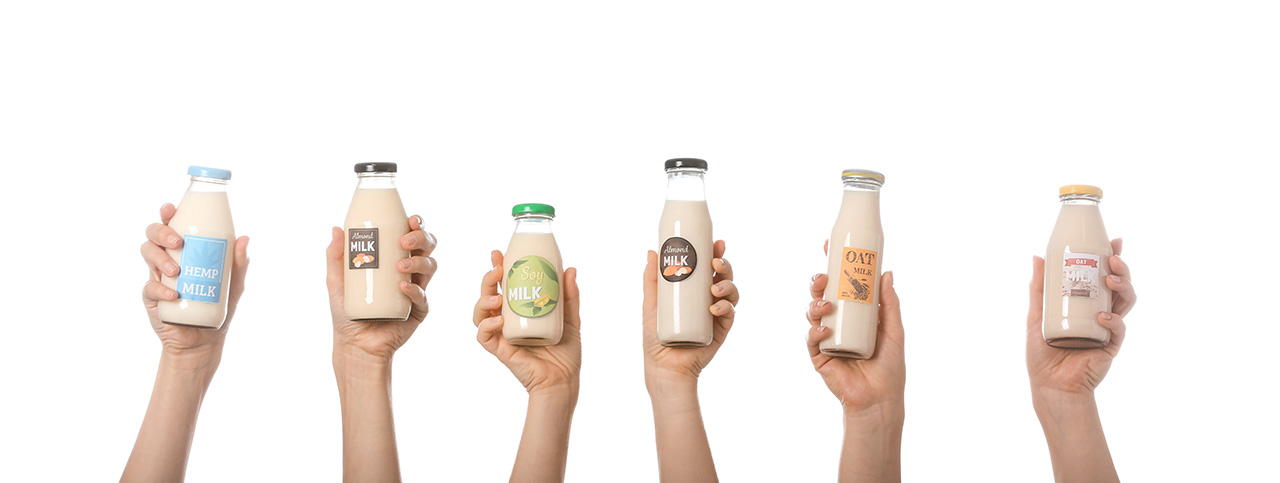Follow us 261.1k
Quick Summary tl;dr
Milk naturally contains lactose, increasing its carb content. One cup of whole milk has about 11.5 g carbs. Whole milk can fit into a low-carb diet in moderation. A flat white or cappuccino is a better choice than a latte.
Cow's milk mostly contains A1 protein which may cause inflammation and gastrointestinal distress. Better options are goat's, sheep's, and buffalo's milk which mostly contain A2 protein.
Dairy-based low-carb alternatives include heavy cream and half & half. Popular non-dairy low-carb milks: coconut, almond, flax, hemp, macadamia, cashew, hazelnut, poppy seed, and tiger nut.
Soy, rice, and oat milk are not ideal for a healthy low-carb diet due to high carbs and other health concerns. Low-fat milk can contain added sugars. When fat is reduced, some nutrients may also be reduced.
Homemade low-carb milk can be made by blending nuts with water and straining. Our guides provide details on making various milks and related products at home.
Milk, with its rich and creamy texture, has been a favorite for many of us. We use it in our morning coffee, with keto-friendly "cereal", or just enjoy a cold glass by itself. But when starting a low-carb or keto diet, the carbs in milk can be a problem. They can easily add up.
This guide will show you low-carb milk alternatives, both dairy and non-dairy, so you can enjoy your meals and stay on track with your diet.
Understanding Carbs in Milk
Milk might seem like a simple, wholesome drink, but there's more to it than meets the eye. It naturally contains a sugar named lactose. This sugar increases the carb content, making it a tricky choice for those watching their carb intake. In simpler terms, if you're counting carbs, just a glass or two of regular milk can take up a big chunk of your daily limit. According to the USDA Food Database, one cup of whole (full-fat) milk contains 11.5 g of carbohydrates, both total and net as there is no fiber in milk.
Exploring Types of Dairy Milk: Nutrition, Taste & Use
Cow's Milk
Many of us are familiar with cow's milk from childhood. Nutritionally, it offers a balance of fats, proteins, and carbs, with carbs being a concern for those following a low-carb diet. It has a neutral flavor, making it a favorite for cereals, coffee, or just by the glass.
Cow's milk contains both A1 and A2 proteins, but it largely depends on the breed of the cow. For instance, Holstein cows, which are the predominant dairy breed in many Western countries, primarily produce milk containing A1 proteins. However, other breeds like the Guernsey or Jersey cow, often produce milk that is richer in A2 proteins, which some folks find gentler on the stomach. Milk that's high in A1 protein can cause inflammation and gastrointestinal distress.
Goat's Milk
Many find goat's milk easier to digest because it contains mostly A2 protein. It has a unique, tangy taste, but milder versions are available. It's creamy and is often turned into delicious cheeses.
Sheep's Milk
Sheep's milk stands out for its rich content of vitamins and minerals. Its creamy texture and strong flavor are great for cheeses like feta and roquefort. Like goat's milk, it contains mostly A2 protein, which can be easier on digestion.

Camel's Milk
While less common, camel's milk is known for its potential health benefits. It has a slightly salty flavor and is often recognized for its possible medicinal properties, like supporting immune health. It's a bit higher in carbs than cow's milk.
Camel's milk averages 5-6 grams of carbs per 100 grams, while cow's milk is around 4-5 grams per 100 grams. However, these numbers can vary depending on factors like the camel's diet and milk processing. Furthermore, camel's milk has more A2 protein and may be easier to digest.
Buffalo Milk
Buffalo milk's creamy consistency is popular in some cultures and is the base for genuine Italian mozzarella and burrata cheese. It contains mostly A2 protein.
Mare's Milk
Mare's milk isn't typical in most markets and has a distinct flavor. Some cultures value it for its nutritional content and use in traditional beverages.
Whole Milk in Moderation? What?!
So, you're wondering about whole milk in a low-carb diet. Can it fit in? Let's break it down.
Whole milk, also known as full-fat milk, is creamy and filling. It doesn't have the extra sugars that some low-fat milks add for flavor. But, whole milk has its own natural sugars, which can add to your carb count.
Here's the deal: if you're watching your carbs closely, you can have whole milk in small amounts. Think of it as a treat. For instance, if you order coffee with whole milk, opt for a cup of flat white or cappuccino, as a latte contains much more milk. Enjoy it, but keep track of how much you drink.
Not sure how many carbs you're adding to your day by drinking milk? Make sure to track your diet with the KetoDiet App!
What's the Deal with Low-Fat Milk?
You might think low-fat milk is a step towards healthier eating. We've all been told that low-fat is good for your waistline.
But here's the catch. When the fat is removed from milk, it can lose its rich flavor. To compensate, some companies add extra sugars, which means you might end up consuming more carbs than anticipated. Moreover, along with the fat, some of the beneficial nutrients in milk can also be lost.
Dairy-Based Low-Carb Milk Alternatives
When most people think of milk, they envision the traditional dairy-based kind. For those on a low-carb journey, standard milk might not fit the bill due to its carb content. But don't worry! Dairy offers other delicious options that align better with a low-carb lifestyle.
These alternatives capture the creaminess of milk, without the high carb count. Let's explore the dairy options available:
- Heavy Cream: Heavy cream is a rich dairy product with almost no carbs. You can dilute it with water to create a milk-like consistency, making it a perfect low-carb substitute for milk in recipes like keto cereal or coffee.
- Half and Half: Half and half is a mix of equal parts milk and cream. It has fewer carbs than regular milk, making it a decent option in moderation. It's a good choice if you're also watching your calorie intake, as the extra fat from too many coffee beverages can quickly add up.

Non-Dairy Low-Carb Milk Alternatives
When selecting a non-dairy milk, it's essential to consider more than just the carb count. It's about choosing clean products. The best milk alternatives contain minimal ingredients, usually just water and the main nut or seed. Avoid those with added sugars, thickeners, or starches. Here are some popular options:
- Coconut Milk: Extracted from coconut flesh, it comes in different forms and uses. The carton version is lighter, much like regular milk – ideal for cereals, coffee, or sipping. The canned variety is denser, suited for cooking, baking, and smoothies, but might be too rich for regular drinking. Each type has unique benefits, with the liquid form containing about 1-2 g carbs per 1/4 cup.
- Almond Milk: Prepared from almonds and water, it's naturally low-carb and a common ingredient in low-carb recipes. It has about 0.5-1 g carbs per 1/4 cup (60 ml).
- Flax Milk: Made from flax seeds, it's rich in omega-3 fatty acids and contains around 0-1 g carbs per 1/4 cup (60 ml).
- Hemp Milk: Derived from hemp seeds, this milk is nutty and packed with beneficial fatty acids. It offers 0-1 g carbs per 1/4 (60 ml).
- Macadamia Milk: Sourced from macadamia nuts, its creamy texture is a delight in coffee. It has roughly 0.5-1 g carbs per 1/4 cup (60 ml).
- Cashew Milk: Ground cashews provide this milk's creamy consistency. It holds about 1-2 g carbs per 1/4 cup (60 ml).
- Hazelnut Milk: Distinct in flavor, it comes from ground hazelnuts and offers around 1-2 g carbs per 1/4 cup (60 ml).
- Poppy Seed Milk: An excellent option for those seeking a nut-free alternative or those not keen on coconut milk. Be aware: poppy seeds can influence drug test results. It contains about 1-2 g carbs per 1/4 cup (60 ml).
- Tiger Nut Milk: Interestingly, tiger nuts are tubers, not nuts. The milk tastes sweet and nutty. It has a higher carb count than most nut or seed milks, so consume it judiciously. It provides about 2-3 g carbs per 1/4 cup (60 ml).
Other nuts can be used for nut & seed milk too: walnuts, pecans, pistachios as well as sesame and sunflower seeds. They're less common but worth a try!
Unsuitable Options for a Healthy Low-Carb Diet
- Rice Milk: Made primarily from processed rice, rice milk is predominantly carbs. With its low protein and fat content, it isn't a good fit for a low-carb diet.
- Oat Milk: Oats form the base for oat milk. While they're considered healthy in many diets, their carb content is significant. This can quickly push you over your daily carb allowance on a low-carb diet.
- Soy Milk: On the surface, soy milk seems like a decent non-dairy choice. However, beyond its carb content, there's another concern. Consuming soy in high amounts might act as an endocrine disruptor, which can interfere with the body's hormonal functions.
Factors to Consider When Choosing a Low-Carb Milk Alternative
When you're on the hunt for the perfect low-carb milk alternative, several factors can sway your choice:
- Nutritional Content: Carb count is vital for those on a low-carb diet, but fat content varies among alternatives. For example, coconut milk is higher in fats, making it creamier compared to many nut or seed milks.
- Taste: Each milk alternative boasts a distinct flavor. While almond milk has a nutty undertone, coconut milk brings a tropical taste. You might need to try a few to find your favorite.
- Purpose: Some milks work better for certain tasks. The richness of coconut milk suits cooking, but you might prefer almond or cashew milk for baking. For sipping, hazelnut milk might be your favorite. It's all about personal taste.
- Price: The cost of milk substitutes can differ. While almond milk is usually budget-friendly, options like macadamia or hazelnut milk may be pricier.
DIY: Making Your Own Low-Carb Milk at Home
Creating your own milk at home is easier than you might imagine! Simply blend nuts like almonds or cashews with water, strain the mixture, and you're well on your way. A pinch of salt or a dash of a healthy sweetener, such as stevia, can elevate your homemade blend. If you're keen to explore further, check out these detailed guides:
Looking for more? These guides might catch your interest:
10 FAQs about Choosing the Right Low-Carb Milk Alternative
1. Why is regular milk not "keto-friendly"?
Regular milk contains lactose, a natural sugar. This increases its carb content, making it less suitable for a strict keto diet where carb intake is very limited.
2. Do I have to avoid milk completely if I follow a keto diet?
No, you don't have to avoid it completely. Whole milk can fit into a keto diet, but in moderation. Whole (full-fat) milk is higher in fats and lacks added sugars, unlike some low-fat versions. However, it's essential to monitor the quantity to ensure you stay within your daily carb limits.
3. Why are some non-dairy milks unsuitable for a low-carb diet?
Some non-dairy milks, like rice and oat milk, are derived from sources that are naturally higher in carbs. Additionally, certain brands on nut and seed milk might use added sugars or fillers, increasing the overall carb content.
4. What should I look for on the nutrition label when choosing a low-carb milk?
Check the total carbohydrates (should be equal to net carbs), sugars, and the ingredient list. Ideally, the product should have minimal carbs, no added sugars, and a clean list of ingredients without unnecessary fillers. The best brands are made with just two ingredients: nuts (or seeds or coconut) and water.
5. Are there any additives or fillers to avoid in store-bought low-carb milks?
Yes. Watch out for added sugars, including seemingly low-carb Sorbitol and Maltitol, corn syrup, and certain thickening agents like carrageenan, which some people prefer to avoid. Keep in mind that most coconut milk products will contain guar gum, which is typically well tolerated but may cause digestive discomfort.
6. How long does homemade nut milk last in the fridge?
Homemade nut milk typically lasts for 3-5 days in the refrigerator. Always store it in a sealed container and give it a good shake before using, as separation is natural.
7. Do low-carb milk alternatives taste similar to regular milk?
Taste can vary. While some might have a similar creamy texture, the flavor often differs based on the source, like almonds, coconut, or hemp. It's a personal preference, so you might need to try a few to find your favorite.
8. Are there any benefits to making my own milk at home?
Yes! Making milk at home allows you to control the ingredients, ensuring no unwanted additives or sugars. It tastes better than most store-bought products and can be more cost-effective in the long run.
9. Can I use all low-carb milk alternatives interchangeably in recipes?
Generally, yes. However, certain alternatives can change the flavor or consistency of a dish. For instance, coconut milk is richer and can add a coconut taste, which may or may not suit a particular recipe. It's especially complementary in Indian-inspired dishes.
10. How do I store leftover canned coconut milk?
Transfer any leftover coconut milk to an airtight container and store it in the refrigerator. Use it within a few days. To store for longer, pour in an ice tray and freeze. Once frozen, empty in a freezer bag and store for up to 6 months.
Conclusion
Finding the right low-carb milk for your needs can be a bit tricky at first. But remember, there's a world of choices waiting for you to explore. From dairy to nut and seed milks, each option brings its own taste and benefits. It might take a little time and a few taste tests, but you're bound to find the one that fits just right into your lifestyle.
Do you like this post? Share it with your friends!
Let us know what you think, rate this post!
